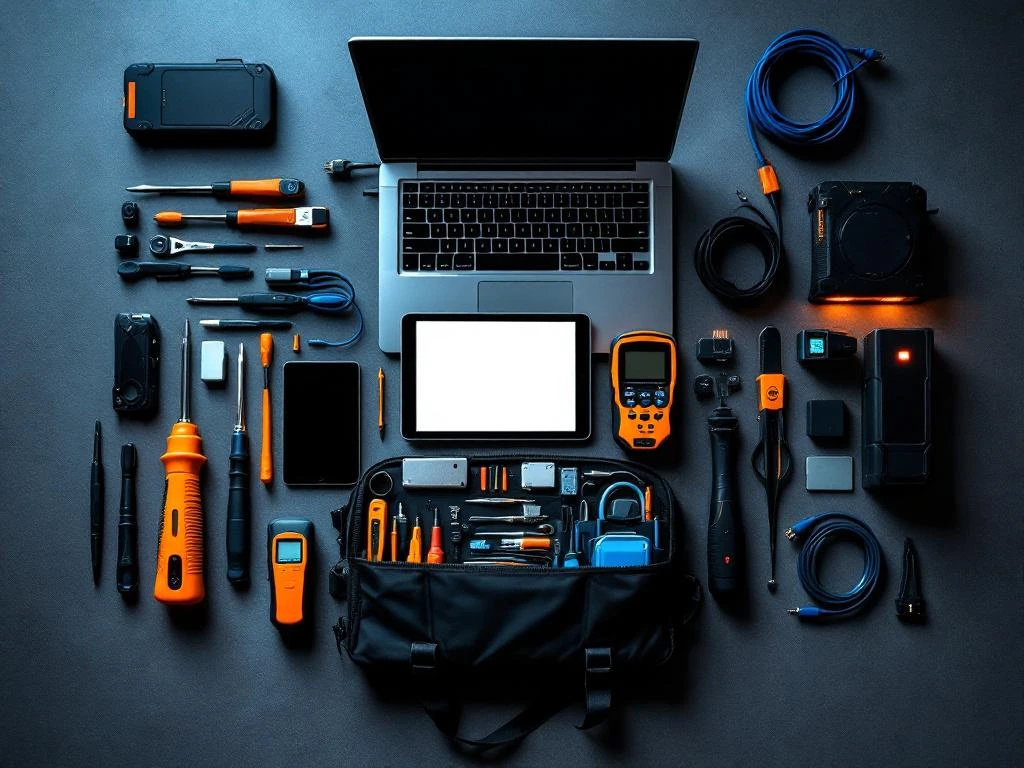
Onsite IT technicians typically carry a comprehensive toolkit containing diagnostic equipment, hardware repair tools, safety gear, and documentation devices. Their mobile arsenal includes cable testers, multimeters, precision screwdrivers, anti-static equipment, and secure storage solutions for sensitive components. Professional technicians also carry specialised software tools on tablets or laptops for system diagnostics, along with replacement parts like cables, adapters, and thermal paste to ensure they can resolve most technical issues during the first visit.
Understanding the onsite IT technician’s mobile toolkit
When you’re managing IT infrastructure across multiple locations, having technicians equipped with the right tools makes all the difference between a quick fix and costly return visits. The mobile toolkit of an onsite IT technician serves as their portable workshop, carefully curated to handle everything from simple cable replacements to complex network diagnostics.
Tool selection directly impacts service quality and those crucial first-time fix rates that keep operations running smoothly. A well-equipped technician can diagnose problems faster, implement solutions more efficiently, and reduce the downtime that affects your business operations. Think of it as the difference between a surgeon arriving with a full medical kit versus just a stethoscope.
The evolution of IT support has transformed these toolkits from simple screwdriver sets into sophisticated collections of diagnostic equipment, specialised hardware tools, and digital devices. Today’s field technicians need to be prepared for anything, from legacy systems still running in manufacturing facilities to cutting-edge cloud infrastructure in modern data centres.
What diagnostic tools do IT technicians need for troubleshooting?
Diagnostic tools form the foundation of effective troubleshooting, allowing technicians to quickly identify the root cause of technical issues rather than guessing. These essential instruments help technicians see what’s happening inside cables, networks, and hardware components, turning invisible problems into solvable challenges.
Cable testers remain indispensable for any technician working with network infrastructure. These devices verify cable integrity, identify wiring faults, and measure signal quality across different cable types. Advanced models can detect issues like crosstalk, impedance problems, and even pinpoint the exact location of a cable break, saving hours of manual inspection.
Network analysers take diagnostics to the next level by providing real-time visibility into network performance. These tools help technicians identify bandwidth bottlenecks, packet loss, and connectivity issues that might otherwise remain hidden. Modern network analysers often include wireless capabilities, allowing technicians to perform comprehensive WiFi surveys and identify coverage gaps or interference sources.
Multimeters serve as the Swiss Army knife of electrical diagnostics, measuring voltage, current, and resistance across various components. For IT technicians, these tools prove invaluable when troubleshooting power supply issues, testing battery backups, or verifying proper grounding in server racks.
Software diagnostic tools have become equally important, with technicians carrying tablets or laptops loaded with specialised applications. These range from system monitoring software that checks hardware health to network scanning tools that map out entire IT environments. Remote access software also allows technicians to collaborate with central support teams, bringing additional expertise to complex field situations.
Which hardware repair tools are standard in an IT toolkit?
Physical repair tools enable technicians to open equipment, replace components, and restore hardware to working condition. A comprehensive hardware toolkit combines precision instruments with practical supplies that address the most common field repair scenarios.
Precision screwdriver sets top the list, featuring multiple bit types and sizes to handle everything from tiny laptop screws to server rack mounting hardware. Magnetic tips help prevent dropped screws in tight spaces, while extension shafts allow access to recessed components. Quality sets include both standard and security bits, as many enterprise devices use tamper-resistant fasteners.
Anti-static equipment protects sensitive electronics from electrostatic discharge damage. This includes wrist straps that ground the technician, anti-static mats for working surfaces, and ESD-safe bags for transporting components. Professional technicians understand that a single static discharge can destroy expensive circuit boards, making proper ESD protection non-negotiable.
Thermal management supplies help maintain optimal operating temperatures for critical components. Technicians carry thermal paste for CPU and heat sink installations, along with cleaning solutions to remove old thermal compounds. Compressed air dusters clear dust from fans and vents, preventing overheating issues that commonly plague IT equipment.
Cable management supplies keep installations neat and professional while improving airflow and accessibility. This includes various sizes of cable ties, velcro straps, and cable labels. Proper cable organisation isn’t just aesthetic, it reduces troubleshooting time and prevents accidental disconnections during future maintenance.
Replacement parts form a crucial component of any field toolkit. Technicians typically carry common items like network cables in various lengths, power cords, adapters, and spare drives. Having these parts on hand means resolving issues immediately rather than scheduling return visits.
What safety and compliance equipment do field technicians carry?
Safety equipment protects both technicians and the equipment they service, while compliance tools ensure work meets regulatory and client requirements. Professional field technicians understand that safety protocols aren’t just bureaucratic requirements, they’re essential for preventing injuries and maintaining service quality.
Personal protective equipment starts with basics like safety glasses to protect against debris when working in server rooms or industrial environments. Proper footwear with slip-resistant soles and steel toes provides protection in data centres where heavy equipment poses risks. Some environments require additional gear like hard hats or high-visibility vests, particularly in manufacturing or logistics facilities.
Anti-static protection goes beyond just wrist straps, encompassing a complete approach to ESD safety. This includes ESD-safe clothing, footwear with conductive soles, and portable grounding points for locations without proper ESD infrastructure. Technicians working in sensitive environments often carry personal ESD monitors that alert them if their grounding becomes compromised.
Documentation tools have evolved from paper checklists to sophisticated digital solutions. Tablets loaded with secure applications allow technicians to access work orders, document completed tasks, and capture photographic evidence of installations or issues. These devices often include encryption and remote wipe capabilities to protect sensitive client data.
Secure storage containers protect both client property and sensitive data during transport. Lockable cases safeguard removed hard drives containing confidential information, while tamper-evident seals provide chain-of-custody documentation. Professional technicians understand that data security extends beyond digital measures to physical protection of hardware components.
Compliance documentation tools help technicians maintain audit trails and meet regulatory requirements. This includes digital forms for recording serial numbers, disposal certificates for decommissioned equipment, and safety checklists specific to different work environments. Having these tools readily available ensures consistent compliance across all service calls.
How do professional IT support providers equip their technicians?
Professional IT support providers understand that consistent service quality requires standardised toolkits across their entire technical team. Rather than leaving tool selection to individual technicians, leading providers develop comprehensive equipment standards that ensure every team member arrives prepared for any situation.
Standardisation starts with defining core toolkit requirements based on the types of services offered and client environments served. Providers analyse common service requests, identify frequently needed tools, and create tiered toolkit configurations for different technician roles. A deskside support specialist might carry different tools than a data centre engineer, but both follow standardised lists appropriate to their responsibilities.
Training programmes ensure technicians know how to use every tool effectively. This goes beyond basic operation to include advanced techniques, safety protocols, and troubleshooting methodologies. Regular refresher training keeps skills sharp and introduces new tools as technology evolves.
Tool maintenance protocols keep equipment in peak condition through regular inspections, calibrations, and replacements. Professional providers schedule periodic toolkit audits, checking for worn tools, expired supplies, and missing items. This proactive approach prevents tool failures during critical service calls.
Quality providers like us at IMPLI-CIT take toolkit management seriously, understanding that properly equipped technicians deliver better outcomes for clients. We ensure our onsite technicians carry comprehensive toolkits tailored to each service scenario, from routine deskside support to complex data centre operations. Our standardised approach means clients receive consistent service quality regardless of which technician responds to their call.
Investment in premium tools reflects a commitment to service excellence. While budget tools might seem adequate, professional-grade equipment offers superior reliability, accuracy, and longevity. This investment pays dividends through faster problem resolution, fewer return visits, and enhanced client satisfaction.
By maintaining rigorous equipment standards and supporting technicians with proper tools and training, professional IT support providers ensure their teams can handle any challenge efficiently. This comprehensive approach to toolkit management forms a cornerstone of reliable onsite IT support, enabling technicians to deliver the consistent, high-quality service that modern businesses require.
How much should I expect to invest in a complete IT technician toolkit?
What’s the best way to organise and transport all these tools efficiently?
How often should diagnostic equipment be calibrated or replaced?
What additional tools are needed for working in industrial or harsh environments?
How can I maintain tool hygiene when working across multiple client sites?
What’s the most commonly forgotten but critical tool for field technicians?
Should technicians carry different toolkits for different types of service calls?
What tools do onsite IT technicians typically carry?
